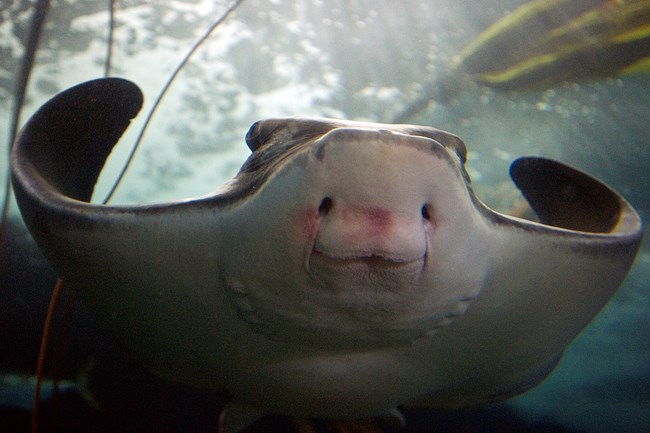
The bat ray (Myliobatis californica) is a common seasonal inhabitant of shallow inshore waters from Oregon to the Gulf of California, and is locally abundant in nutrient rich bays such as Tomales Bay in Point Reyes National Seashore. Bat rays have very sharp and durable teeth that are capable of crushing even the toughest clam and crab shells. The species was long thought to prey upon cultivated oysters, and were routinely killed within oyster nursery grounds. The attempt at eradication proved to be a mislead effort, however, as the bat rays were actually preying upon crabs that feed on oyster beds.
Researchers
Joseph Cech
Professor Emeritus of Fish Biology
University of California, Davis
Researcher Website
Research Interests: Physiological Ecology of Fishes
Peter Klimley
Bodega Marine Laboratory, University of California, Davis
Researcher Website
Research Interests: The role of sensory physiology in orientation, predator-prey interactions, ultrasonic tracking and telemetry, and tracking white sharks for the TOPP (Tagging of Pelagic Predators) program.
References
Gray, A., T. Mulligan, and R. Hannah. 1997. Food habits, occurrence, and population structure of the bat ray, Myliobatis californica, in Humboldt Bay, California. Environmental Biology of Fishes 49:227-238.
Herald, E. S. 1951. The relative abundance of sharks and bay stingrays in San Francisco Bay. California Fish and Game 37:315-329.
Hopkins, T. E. and J. J. Cech. 1994. Effects of temperature on oxygen consumption of the bat ray, Myliobatis californica (Chondrichthyes, Myliobatididae). Copeia 2:529-532.
Hopkins, T. E. and J. J. Cech. The influence of environmental variables on the distribution and abundance of three elasmobranchs in Tomales Bay, California. Environmental Biology of Fishes 66:279-291.
Hopkins, T.E. and J.J. Cech. 1992. The Physiology and ecology of bat rays in Tomales Bay In The Third Biennial Sate of Tomales Bay Coference. Iverness Yacht Club, Iverness, CA.
Klimley, A. P., J. T. Kelly, and R. L. Kihslinger. 2005. Directional and non-directional movements of bat rays, Myliobatis californica, in Tomales Bay, California. Environmental Biology of Fishes 74:79-88.
Martin, L.K. and G. M. Cailliet. 1988. Aspects of the reproduction of the bat ray, Myliobatis californica, in Central California. Copeia 3:754-762.
Matern, S. A., J. J. Cech, and T. E. Hopkins. 2000. Diel movements of bat rays, Myliobatis californica, in Tomales Bay, California: evidence for behavioral thermoregulation? Environmental Biology of Fishes 58:173-182.
Michael, S. 1993. Reef Sharks & Rays of the World: A guide to their identification, behavior, and ecology. Monterey, California: Sea Challengers.
Talent, L. 1982. Food habits of the gray smoothhound, Mustelus californicus, the brown smoothhound, Mustelus henlei, the shovelnose guitarfish, Rhinobatos productus, and the bat ray, Myliobatis californicus, in Elkhorn Slough, California. California Fish and Game, 68:224-234.
Tricas, T. C. 1980. Courtship and mating-related behaviors in myliobatid rays. Copeia 3:553-556.
Links
MarineBio Bat Ray Species Report
Monterey Bay Aquarium Bat Ray Species Description
Last updated: May 22, 2017
